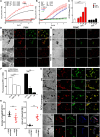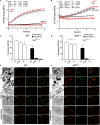Oxidative Burst-Dependent NETosis Is Implicated in the Resolution of Necrosis-Associated Sterile Inflammation
- PMID: 27990145
- PMCID: PMC5131011
- DOI: 10.3389/fimmu.2016.00557
Oxidative Burst-Dependent NETosis Is Implicated in the Resolution of Necrosis-Associated Sterile Inflammation
Erratum in
-
Corrigendum: Oxidative burst-dependent NETosis is implicated in the resolution of necrosis-associated sterile inflammation.Front Immunol. 2025 Mar 26;16:1593749. doi: 10.3389/fimmu.2025.1593749. eCollection 2025. Front Immunol. 2025. PMID: 40207237 Free PMC article.
Abstract
Necrosis is associated with a profound inflammatory response. The regulation of necrosis-associated inflammation, particularly the mechanisms responsible for resolution of inflammation is incompletely characterized. Nanoparticles are known to induce plasma membrane damage and necrosis followed by sterile inflammation. We observed that injection of metabolically inert nanodiamonds resulted in paw edema in WT and Ncf1** mice. However, while inflammation quickly resolved in WT mice, it persisted over several weeks in Ncf1** mice indicating failure of resolution of inflammation. Mechanistically, NOX2-dependent reactive oxygen species (ROS) production and formation of neutrophil extracellular traps were essential for the resolution of necrosis-induced inflammation: hence, by evaluating the fate of the particles at the site of inflammation, we observed that Ncf1** mice deficient in NADPH-dependent ROS failed to generate granulation tissue therefore being unable to trap the nanodiamonds. These data suggest that NOX2-dependent NETosis is crucial for preventing the chronification of the inflammatory response to tissue necrosis by forming NETosis-dependent barriers between the necrotic and healthy surrounding tissue.
Keywords: NETosis; inflammation; nanodiamonds; necrosis; reactive oxygen species; resolution.
Conflict of interest statement
The authors declare that the research was conducted in the absence of any commercial or financial relationships that could be construed as a potential conflict of interest.
Figures





Similar articles
-
Corrigendum: Oxidative burst-dependent NETosis is implicated in the resolution of necrosis-associated sterile inflammation.Front Immunol. 2025 Mar 26;16:1593749. doi: 10.3389/fimmu.2025.1593749. eCollection 2025. Front Immunol. 2025. PMID: 40207237 Free PMC article.
-
Hypertonic Saline Suppresses NADPH Oxidase-Dependent Neutrophil Extracellular Trap Formation and Promotes Apoptosis.Front Immunol. 2018 Mar 8;9:359. doi: 10.3389/fimmu.2018.00359. eCollection 2018. Front Immunol. 2018. PMID: 29593709 Free PMC article.
-
The role of NOX2-derived reactive oxygen species in collagenase-induced osteoarthritis.Osteoarthritis Cartilage. 2018 Dec;26(12):1722-1732. doi: 10.1016/j.joca.2018.08.014. Epub 2018 Sep 5. Osteoarthritis Cartilage. 2018. PMID: 30195046
-
The kiss of (cell) death: can venom-induced immune response contribute to dermal necrosis following arthropod envenomations?Clin Toxicol (Phila). 2019 Aug;57(8):677-685. doi: 10.1080/15563650.2019.1578367. Epub 2019 Feb 26. Clin Toxicol (Phila). 2019. PMID: 30806093 Review.
-
How Do ROS Induce NETosis? Oxidative DNA Damage, DNA Repair, and Chromatin Decondensation.Biomolecules. 2024 Oct 16;14(10):1307. doi: 10.3390/biom14101307. Biomolecules. 2024. PMID: 39456240 Free PMC article. Review.
Cited by
-
Acetylated Histones in Apoptotic Microparticles Drive the Formation of Neutrophil Extracellular Traps in Active Lupus Nephritis.Front Immunol. 2017 Sep 14;8:1136. doi: 10.3389/fimmu.2017.01136. eCollection 2017. Front Immunol. 2017. PMID: 28959262 Free PMC article.
-
NETosis as a Pathogenic Factor for Heart Failure.Oxid Med Cell Longev. 2021 Feb 23;2021:6687096. doi: 10.1155/2021/6687096. eCollection 2021. Oxid Med Cell Longev. 2021. PMID: 33680285 Free PMC article. Review.
-
Disease-Associated Particulates and Joint Inflammation; Mechanistic Insights and Potential Therapeutic Targets.Front Immunol. 2018 May 28;9:1145. doi: 10.3389/fimmu.2018.01145. eCollection 2018. Front Immunol. 2018. PMID: 29892292 Free PMC article. Review.
-
Resolution Potential of Necrotic Cell Death Pathways.Int J Mol Sci. 2022 Dec 20;24(1):16. doi: 10.3390/ijms24010016. Int J Mol Sci. 2022. PMID: 36613458 Free PMC article. Review.
-
Reactive Oxygen Species Deficiency Due to Ncf1-Mutation Leads to Development of Adenocarcinoma and Metabolomic and Lipidomic Remodeling in a New Mouse Model of Dextran Sulfate Sodium-Induced Colitis.Front Immunol. 2018 May 14;9:701. doi: 10.3389/fimmu.2018.00701. eCollection 2018. Front Immunol. 2018. PMID: 29867918 Free PMC article.
References
LinkOut - more resources
Full Text Sources
Other Literature Sources
Molecular Biology Databases
Miscellaneous

